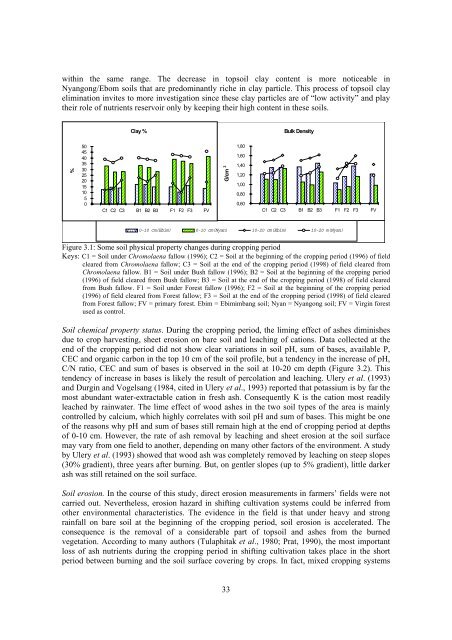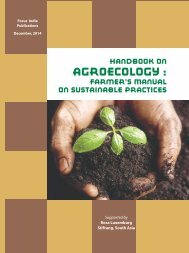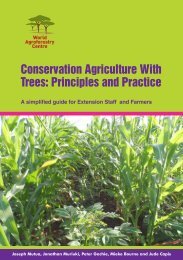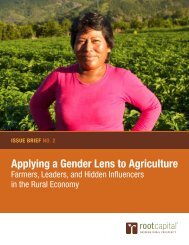1t0SC7l
1t0SC7l
1t0SC7l
You also want an ePaper? Increase the reach of your titles
YUMPU automatically turns print PDFs into web optimized ePapers that Google loves.
within the same range. The decrease in topsoil clay content is more noticeable in<br />
Nyangong/Ebom soils that are predominantly riche in clay particle. This process of topsoil clay<br />
elimination invites to more investigation since these clay particles are of “low activity” and play<br />
their role of nutrients reservoir only by keeping their high content in these soils.<br />
Clay %<br />
Bulk Density<br />
%<br />
50<br />
45<br />
40<br />
35<br />
30<br />
25<br />
20<br />
15<br />
10<br />
5<br />
0<br />
C1 C2 C3 B1 B2 B3 F1 F2 F3 FV<br />
G/cm 3<br />
1,80<br />
1,60<br />
1,40<br />
1,20<br />
1,00<br />
0,80<br />
0,60<br />
C1 C2 C3 B1 B2 B3 F1 F2 F3 FV<br />
0-10 cm(Ebim) 0-10 cm(Nyan) 10-20 cm(Ebim) 10-20 m(Nyan)<br />
Figure 3.1: Some soil physical property changes during cropping period<br />
Keys: C1 = Soil under Chromolaena fallow (1996); C2 = Soil at the beginning of the cropping period (1996) of field<br />
cleared from Chromolaena fallow; C3 = Soil at the end of the cropping period (1998) of field cleared from<br />
Chromolaena fallow. B1 = Soil under Bush fallow (1996); B2 = Soil at the beginning of the cropping period<br />
(1996) of field cleared from Bush fallow; B3 = Soil at the end of the cropping period (1998) of field cleared<br />
from Bush fallow. F1 = Soil under Forest fallow (1996); F2 = Soil at the beginning of the cropping period<br />
(1996) of field cleared from Forest fallow; F3 = Soil at the end of the cropping period (1998) of field cleared<br />
from Forest fallow; FV = primary forest. Ebim = Ebimimbang soil; Nyan = Nyangong soil; FV = Virgin forest<br />
used as control.<br />
Soil chemical property status. During the cropping period, the liming effect of ashes diminishes<br />
due to crop harvesting, sheet erosion on bare soil and leaching of cations. Data collected at the<br />
end of the cropping period did not show clear variations in soil pH, sum of bases, available P,<br />
CEC and organic carbon in the top 10 cm of the soil profile, but a tendency in the increase of pH,<br />
C/N ratio, CEC and sum of bases is observed in the soil at 10-20 cm depth (Figure 3.2). This<br />
tendency of increase in bases is likely the result of percolation and leaching. Ulery et al. (1993)<br />
and Durgin and Vogelsang (1984, cited in Ulery et al., 1993) reported that potassium is by far the<br />
most abundant water-extractable cation in fresh ash. Consequently K is the cation most readily<br />
leached by rainwater. The lime effect of wood ashes in the two soil types of the area is mainly<br />
controlled by calcium, which highly correlates with soil pH and sum of bases. This might be one<br />
of the reasons why pH and sum of bases still remain high at the end of cropping period at depths<br />
of 0-10 cm. However, the rate of ash removal by leaching and sheet erosion at the soil surface<br />
may vary from one field to another, depending on many other factors of the environment. A study<br />
by Ulery et al. (1993) showed that wood ash was completely removed by leaching on steep slopes<br />
(30% gradient), three years after burning. But, on gentler slopes (up to 5% gradient), little darker<br />
ash was still retained on the soil surface.<br />
Soil erosion. In the course of this study, direct erosion measurements in farmers’ fields were not<br />
carried out. Nevertheless, erosion hazard in shifting cultivation systems could be inferred from<br />
other environmental characteristics. The evidence in the field is that under heavy and strong<br />
rainfall on bare soil at the beginning of the cropping period, soil erosion is accelerated. The<br />
consequence is the removal of a considerable part of topsoil and ashes from the burned<br />
vegetation. According to many authors (Tulaphitak et al., 1980; Prat, 1990), the most important<br />
loss of ash nutrients during the cropping period in shifting cultivation takes place in the short<br />
period between burning and the soil surface covering by crops. In fact, mixed cropping systems<br />
33








